ASUS Z97-Pro WiFi AC Review
by Ian Cutress on July 16, 2014 10:00 AM EST- Posted in
- Motherboards
- Asus
- Haswell
- 802.11ac
- Z97
System Benchmarks
Power Consumption
Power consumption was tested on the system as a whole with a wall meter connected to the OCZ 1250W power supply, while in a single MSI GTX 770 Lightning GPU configuration. This power supply is Gold rated, and as I am in the UK on a 230-240 V supply, leads to ~75% efficiency > 50W, and 90%+ efficiency at 250W, which is suitable for both idle and multi-GPU loading. This method of power reading allows us to compare the power management of the UEFI and the board to supply components with power under load, and includes typical PSU losses due to efficiency. These are the real world values that consumers may expect from a typical system (minus the monitor) using this motherboard.
While this method for power measurement may not be ideal, and you feel these numbers are not representative due to the high wattage power supply being used (we use the same PSU to remain consistent over a series of reviews, and the fact that some boards on our test bed get tested with three or four high powered GPUs), the important point to take away is the relationship between the numbers. These boards are all under the same conditions, and thus the differences between them should be easy to spot.
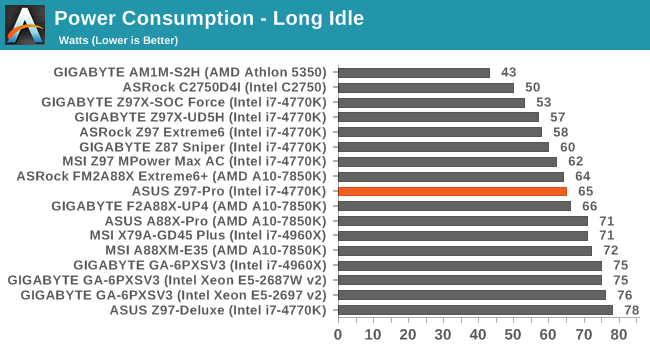
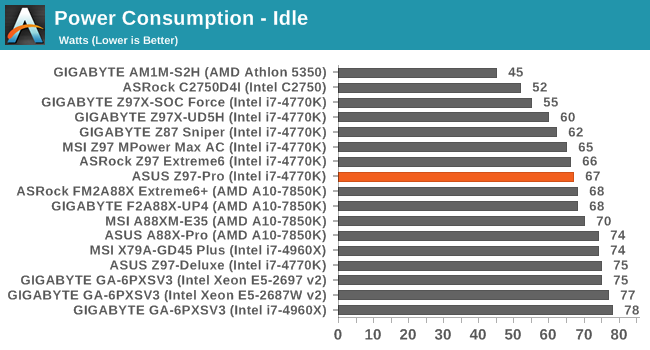
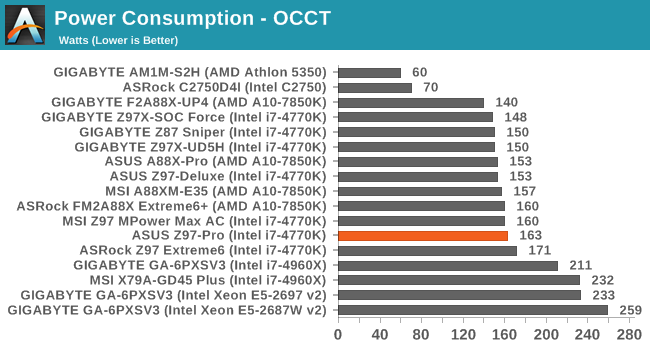
The idle and long idle power consumption seems higher than other motherboards we have tested, and the OCCT power consumption is also in the higher bracket.
Windows 7 POST Time
Different motherboards have different POST sequences before an operating system is initialized. A lot of this is dependent on the board itself, and POST boot time is determined by the controllers on board (and the sequence of how those extras are organized). As part of our testing, we are now going to look at the POST Boot Time - this is the time from pressing the ON button on the computer to when Windows 7 starts loading. (We discount Windows loading as it is highly variable given Windows specific features.) These results are subject to human error, so please allow +/- 1 second in these results.
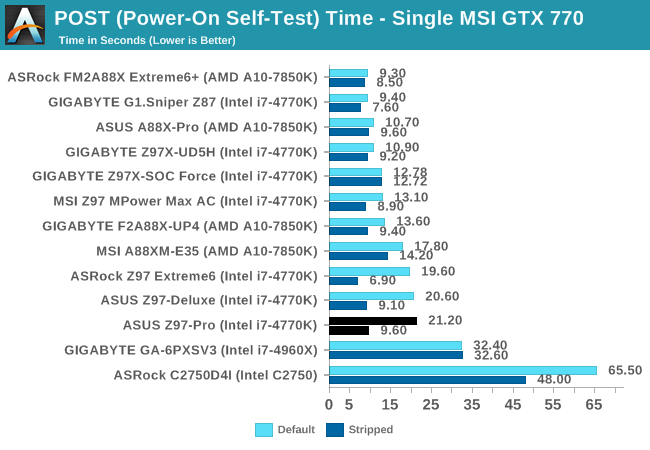
While the default POST time for the Z97-Pro is 20+ seconds, there are three reasons for this. The first reason relates to the controllers, as shown by the stripped POST time of 9.6 seconds. The second is the shift towards Windows 8, which affords a much faster POST time when Windows 8 fast boot options are enabled. As a result, motherboard manufacturers might not immediately look at POST time optimization as a primary focus. Third is the timing when we tested the Pro, which was still in the late beta phase around launch, meaning that ASUS had not optimized the BIOS for POST timing. This is ultimately a downside of testing this early in the chipset lifetime.
Rightmark Audio Analyzer 6.2.5
The premise behind Rightmark:AA is to test the input and output of the audio system to determine noise levels, range, harmonic distortion, stereo crosstalk and so forth. Rightmark:AA should indicate how well the sound system is built and isolated from electrical interference (either internally or externally). For this test we connect the Line Out to the Line In using a short six inch 3.5mm to 3.5mm high-quality jack, turn the OS speaker volume to 100%, and run the Rightmark default test suite at 192 kHz, 24-bit. The OS is tuned to 192 kHz/24-bit input and output, and the Line-In volume is adjusted until we have the best RMAA value in the mini-pretest. We look specifically at the Dynamic Range of the audio codec used on board, as well as the Total Harmonic Distortion + Noise.
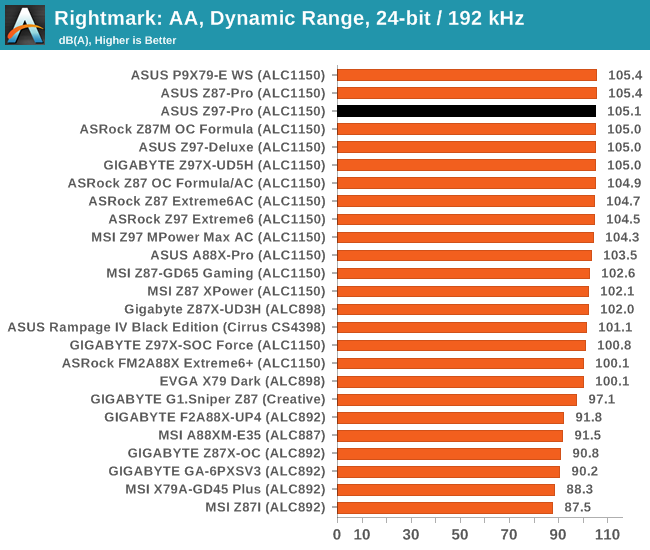
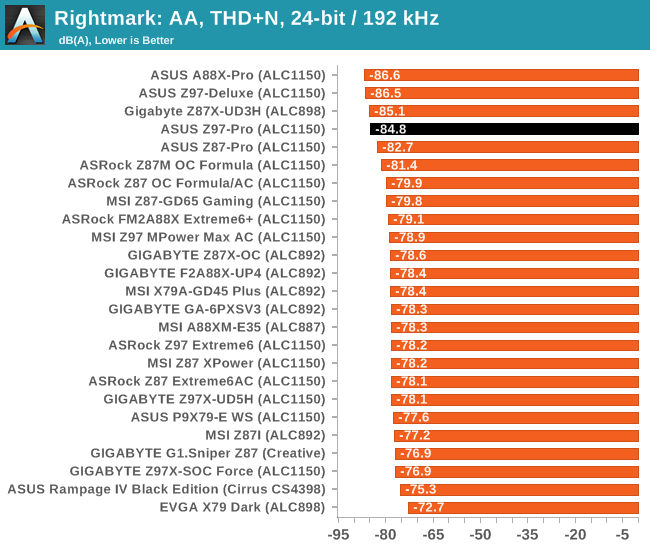
Both the results of the Dynamic Range and the THD+N put the Z97-Pro really high in our audio testing.
USB Backup
For this benchmark, we run CrystalDiskMark to determine the ideal sequential read and write speeds for the USB port using our 240 GB OCZ Vertex3 SSD with a SATA 6 Gbps to USB 3.0 converter. Then we transfer a set size of files from the SSD to the USB drive using DiskBench, which monitors the time taken to transfer. The files transferred are a 1.52 GB set of 2867 files across 320 folders – 95% of these files are small typical website files, and the rest (90% of the size) are the videos used in the WinRAR test. In an update to pre-Z87 testing, we also run MaxCPU to load up one of the threads during the test which improves general performance up to 15% by causing all the internal pathways to run at full speed.
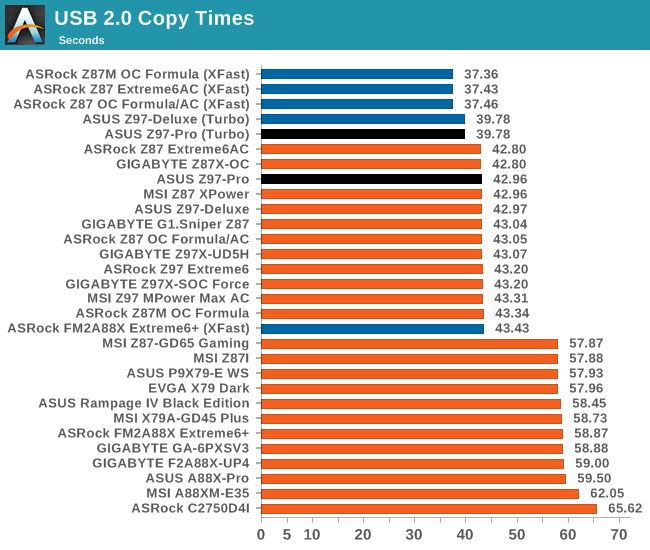

DPC Latency
Deferred Procedure Call latency is a way in which Windows handles interrupt servicing. In order to wait for a processor to acknowledge the request, the system will queue all interrupt requests by priority. Critical interrupts will be handled as soon as possible, whereas lesser priority requests, such as audio, will be further down the line. So if the audio device requires data, it will have to wait until the request is processed before the buffer is filled. If the device drivers of higher priority components in a system are poorly implemented, this can cause delays in request scheduling and process time, resulting in an empty audio buffer – this leads to characteristic audible pauses, pops and clicks. Having a bigger buffer and correctly implemented system drivers obviously helps in this regard. The DPC latency checker measures how much time is processing DPCs from driver invocation – the lower the value will result in better audio transfer at smaller buffer sizes. Results are measured in microseconds and taken as the peak latency while cycling through a series of short HD videos - less than 500 microseconds usually gets the green light, but the lower the better.

The focus of 9-series motherboards on DPC Latency is quite surprising, meaning that we might have to realign our standards. Anything under 100 microseconds is still an awesome result, and the Z97 Pro scores 88.











38 Comments
View All Comments
Samus - Wednesday, July 16, 2014 - link
I'm running a system based on the Asus Z97I-Plus (ITX) with a i5-4690K @ 4.5GHz 1.3v its been rock solid for the month I've had it.Coming from an Asus H81I ITX i5-4670K @ 4.2GHz. There are some mild BIOS improvements but the addition of M2 on the Z97I was what got me. That, and my H81 wouldn't run the Haswell refresh (chipset was old version) so I was pretty much locked into Haswell with no Broadwell/Skylake options for the future.
mapesdhs - Saturday, July 19, 2014 - link
Sounds good! I'm curious though, how are you cooling your 4690K? I've been pondering
whether a K CPU with a moderate oc is viable given I want minimum noise (for the HTPC
build that is).
Ian.
p1esk - Wednesday, July 16, 2014 - link
How could 2x580 be possibly quicker than Titan Black? It's 2x512 cores vs 2,880 cores at higher clock, and Titan has twice memory bandwidth.ZeDestructor - Thursday, July 17, 2014 - link
The cores perform differently. Similar to how clock for clock Haswell is faster than IVB. In this case, the 580 has more powerful, but slower and hotter cores than the titan black.By the looks of it, the blender code isn't memory bound either, which explains why it makes do with the lower bandwidth.
mapesdhs - Saturday, July 19, 2014 - link
As ZeDestructor says, the shader structure is very different in the 500 series, but to
clarify: after the 500 series, NVIDIA halved the shader clock speeds in order to make
power delivery & heat easier to deal with, but this means a lot more shaders are
required to give the same performance (almost 3X as many), eg. I've tested a K5000
which has 3X more shaders, but it's slower than a 580 for CUDA. This is why, for CUDA
tasks, a 580 beats all of the 600 series and most of the 700 series. Also, the 580 has a
lot of bandwidth, so the available bandwidth per core is very high compared to later
designs; this can make a difference in some cases.
See the following (for the Arion test, my system is no. 18 in the table; also note the table
has a typo, system 15 is a triple-780):
http://www.randomcontrol.com/arionbench
http://www.tomshardware.co.uk/forum/id-2173987/gig...
http://forums.creativecow.net/thread/2/1019120
A Titan Black does the Blender BMW/Cycles test in 24 seconds. My quad-580 system does
it in 11.56 seconds.
Summary: for CUDA, two 580s are quicker than a Titan, making them a good budget option
for AE users, etc., though of course it makes sense if possible to obtain 3GB models.
For 3D gaming though, the situation is completely different. Likewise, a CUDA task
requiring mostly FP64 would be better with Titans.
Ian.
FriendlyUser - Wednesday, July 16, 2014 - link
I particularly appreciate the Intel 218V Lan. An excellent choice. Together with the decent onboard audio, you really get some premium hardware for your money. I don't particularly care for the Wi-Fi AC controller, though. These things change so fast, I'd rather have an expansion card (for example, the 802.11ac spec could theoretically scale up to several Gbs). Plus, I prefer getting WiFi equipment from the same vendor, to simplify installation and interoperability.DanNeely - Wednesday, July 16, 2014 - link
I'm ambivalent about the wifi, since I'd only ever use it as a temporary backup option.What annoys me a bit is that it looks like the connector is a PCIe 1x slot that was moved closer to the back edge of the board. If they wanted to play fast and loose with the standard to get wifi out in the IO port area instead of the expansion card area; if they'd put the adapter where the audio out is and at the standard distance from the edge it would be possible to kludge an off the shelf card in as an upgrade by removing it's bracket and either removing the IO shield or trimming it out with a cutting tool.
ZeDestructor - Thursday, July 17, 2014 - link
What's even more annoying is that they're not using a standard miniPCIe or M.2 wifi card instead with some internal U.Fl to RP-SMA coax cabling from somewhere else (right behind the PCIe 1x slots comes to mind) on the board.Btw, it seems thay are using something that's more than PCIe x1 but less than PCIe x4.. nice and proprietary.
Antronman - Wednesday, July 16, 2014 - link
Not even Asus' top end, and it already blows away the competition...Samus - Wednesday, July 16, 2014 - link
Yeah I'm surprised what a value it actually is. Sub-$200 and you get Intel Gigabit, Xonar-class audio, M.2, VRM heatsinks and all the typical Z97 stuff. I also like the 90-series motherboard color schemes. They're actually reminiscent of ASRock's. The 80-series Asus boards had a weird color combo (yellow DIMM slots, for example) but ASRock had this Black/Gold theme.And I don't care what people say, I've had Asus boards since the i486 days and every single one has been incredibly solid.